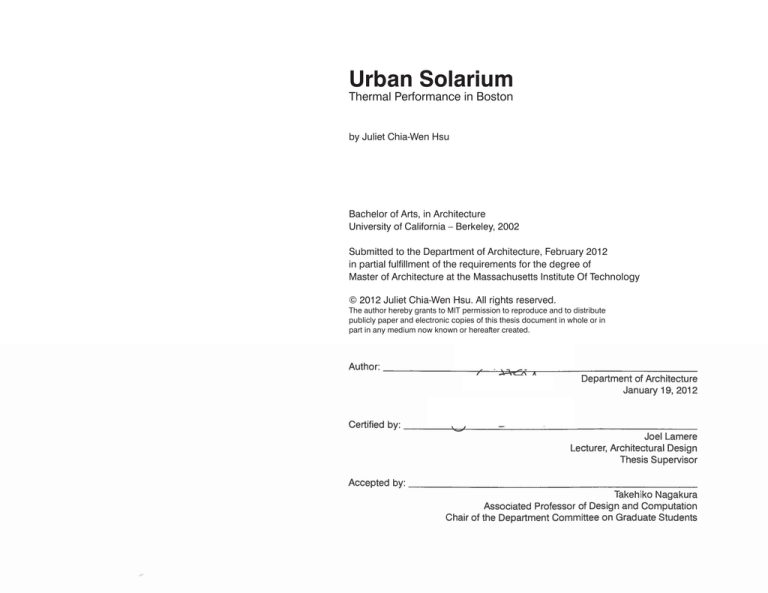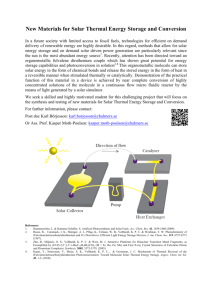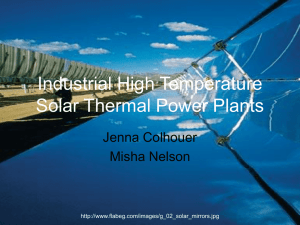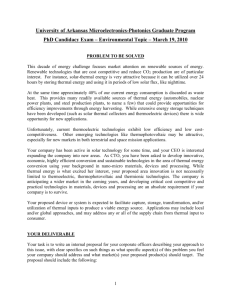
Urban Solarium
Thermal Performance in Boston
by Juliet Chia-Wen Hsu
Bachelor of Arts, in Architecture
University of California – Berkeley, 2002
Submitted to the Department of Architecture, February 2012
in partial fulfillment of the requirements for the degree of
Master of Architecture at the Massachusetts Institute Of Technology
© 2012 Juliet Chia-Wen Hsu. All rights reserved.
The author hereby grants to MIT permission to reproduce and to distribute
publicly paper and electronic copies of this thesis document in whole or in
part in any medium now known or hereafter created.
2
Thesis Committee
Advisor
Joel Lamere
Lecturer, Architectural Design
MIT Department of Architecture
Readers
John Fernandez
Associate Professor of Architecture and Building Technology
MIT Department of Architecture
Yung Ho Chang
Professor of Architecture
MIT Department of Architecture
3
4
Urban Solarium
Thermal Performance in Boston
by Juliet Chia-Wen Hsu
Submitted to the Department of Architecture, February 2012
in partial fulfillment of the requirements for the degree of
Master of Architecture at the Massachusetts Institute Of Technology
Abstract
This thesis addresses the issue of energy efficiency through the lens of thermal
performance in the context of urban housing in the city of Boston. Located in the
historic brick row house neighborhood of the South End, the project utilizes brick
for its inherent property of high heat capacity – a material’s ability to store radiant
energy and release it later due to the temperature difference between day and
night – as a thermal battery for heating and cooling domestic spaces.
In Boston where the temperature frequently goes below freezing in winter time,
this thesis challenges existing housing typologies by incorporating thermal mass
as a passive solar strategy at the scale of an entire structure. The urban solarium
produces an interstitial zone in housing that promotes a new lifestyle by bringing
together thermal performance and urban farming.
Thesis Supervisor: Joel Lamere
Title: Lecturer, Architectural Design
5
Acknowledgements
To my advisory committee: Thank you Joel, for your comments, suggestions, and
guidance throughout this entire process. To John, for your invaluable insight and
advice. To Yung Ho, for making time and your words of wisdom.
To Andy Hsu, August Liau, and Jessi Turner: for your generosity and incredible
effort in the lead up to my final review. To Carolyn, Emily, Rena, Chris, Kelly, Shiyu,
and Laura: for lending a hand in time of need. Special thanks to Zahraa Saiyed
and Amanda Webb for your help on thermal analysis and simulation.
To my classmates and friends at MIT: for the laughs, coffee runs, and late night
camaraderie, and most of all for being a part of this roller coaster ride.
To Jack, thank you for being my rock and for motivating me to go to MIT. I would not
have been able to finish without your unconditional support and encouragement.
To my family and friends, for your love and support during this incredible journey!
6
Table of Contents
Introduction .......................................................................................................... 9
Research .............................................................................................................. 17
18
Climate
22
Material
25
Performance
Design .................................................................................................................. 37
38
Site
41
Strategy
44
Geometry
48
Solarium Schedule
52
Plans and Sections
60
Model Photographs
Final Review ......................................................................................................... 65
Bibliography ......................................................................................................... 67
7
8
INTRODUCTION
9
10
House : Experimentation
The single-family housing typology had long been a codified space with specific
sets of rules and regulations. As family structures and lifestyles evolved, resulting
in programmatic changes; the house nevertheless has remained a laboratory
for experimentation of emerging disciplinary developments. To operate in the
realm of domestic architecture, one must understand the house not only as an
intimate landscape, but also as an artifact of culture with larger ramifications. The
instrumentality of the house therefore lies in its easy relation to the general public
beyond the discourse of architecture.
Historical precedents of collective experimentations in the single-family housing
typology ranges from Weissenhof siedlung in Stuttgart, Germany in 1920’s to the
Case Study Houses in Los Angeles, California of the postwar era. As communities
of houses, both movements proved to be didactic. In the former, Mies van der Rohe,
Le Corbusier, Walter Gropius and others combined “mixed-income residences to
advocate modernism’s social potential during a time of housing shortages” and
in the latter, Richard Neutra, Charles and Ray Eames, Eero Saarinen, and others
“constructed daring examples of affordable modern homes for a country immersed
in a building boom”. What then, is the proper expression of housing experimentation
for today?
House : Nature
From John Ruskin’s notion of habitation in the landscape to Le Corbusier’s Five
Points of Architecture, the relationship between the house and its surrounding
environment had shifted. Modernism’s quest for transparency lead to an increased
exchanged between the inhabitant and its habitat in terms of accessibility as well as
visibility. In Los Angeles, California, the production of the Case Study Houses and
the collective incorporation of the open floor plan, a sequence of continuous volumes
that culminates in a variety of indoor and outdoor spaces. In contemporary practices
of architecture, a similar desire to connect to the landscape remains, more so than
ever it is revealed in the area of the envelope. Not only are traditional materials
appropriated, new materials explored, a crop of hybrid materials are also currently
available for architects to deploy.
11
House : Envelope
Recent developments in the realm of surface and envelope research often manifests
in one of two scales – standalone installations or full-scale implementation at the size
of a stadium, shopping mall, and a variety of large-scale civic buildings that “do not
require any relationship between inside and outside.” These objects, consumed
in the format of books and magazine photo or on websites, are often considered
to be beyond the reach of the general public. Therefore, projections of the latest
technological advancements in the realm domestic architecture is eminent in order
to reach a broader demographic.
To situate the discussion of the house as an envelope, one can begin the discourse
from the thick to the thin, from poché space in Roman architecture to Gottfried
Semper’s theory of original enclosure, as textile or woven mat between poles.
Furthermore, the tension between ornament and function will find relevance in both
Adolf Loos’ argument of Ornament and Crime as well as Venturi Scott Brown’s
theory of the decorated shed . According to K. Michael Hays, “the experience of the
[new] architectural envelope is no longer distinctive but is now part of an aesthetic
experience that is diffused through and saturates every part of our lives.” While
technology have afforded us digital tools to aid in both the design (software) and the
fabrication (hardware) of new envelopes, these digital tools have yet to permeate the
canonical means and methods of standard residential construction.
12
House : Materiality
Furthermore, the current state of discourse on material and envelope has remained
at the level of producing architectural phenomenon through the manipulation of
opacity, translucency, and textures. The shifted focus from “static material properties
to dynamic material behaviors” at the level of academic research has captured the
attention and sparked interest in the discipline of architecture. The changing nature
of material through the fourth dimension of time demands a radical transformation
that will require a new architectural paradigm. Concerns of sustainability and issues
of ecology are often brought into question when evaluating new materials and new
methods of production and application. The embodied energy of material production
is just as important as the effects that it produces.
Passive strategies that engage the local climate, mediation of air and lighting
condition, as well as seasonal changes typically have been incorporated into
standard architectural practices today. However, work remains in the architectural
invention and application of active strategies such as local electric generation,
responsive materials, and embedded intelligence in interactive systems. This new
crop of performance driven materials and its application will be the subject that
occupies a new generation of architectural practices.
In conclusion, this thesis intends to catalogue the current state of material practices
and address issues of the ever diminishing wall thickness. The house is at once an
experiment, a place for nature, an expression of tectonics (envelope), that which
is measured through its engagement of materiality. Energy production, material
efficiency and efficacy can be addressed simultaneously through alternative modes
of material application.
13
14
1
C 89
W hica 5
hit go R
et ,I e
er L; lia
ra B
-c ur nc
ot ha e
ta m B
cu an u
tai d il
n Ro di
wa o n
g
ll t
N 88
ter ew 6
ra Yor P
-c k, o
ot N tt
ta, Y er
40
Bu
”
ild
18 thick
in
Ch 8
wa
g
28 ica 9
ll
tap st go, M
er ory IL on
st s ;D a
o tru an d
18 ct ie n
” w ure l B oc
all , 6 urn k
’ b ha B
ric m ui
ld
kb
in
as
g
e
1
7
di 500
sc B
ov C
er Ol
ed de
in st
40
Sy bri
0
dr 0
ria ck
ie B
d C
br F
ick irs
in t su
1
Ira nW 900
q
al B
lo C
fJ W
er es
us te
al rn
6
em
of 00 B
Ch C
in Gr
a
ea
tW
10
al
0
l
AD
Ro
m
an
53
Br
7
ick
AD
Ha
gi
a
So
10
fia
st 00
up A
as D
in Br
M ick
ya
nm
ar
1st INDUSTRIAL REVOLUTION
Lo 5
Lo nd 1
Ca ndo on, Cr
st- n En y
iro Wo gla st
n rld nd al
an
d Exp ; Jo Pa
gla o se la
ss siti ph c
18 struc on 18 Paxto e
Liv 6
tu 51 n
4
re
Fir erp
st oo O
m l, ri
eta En e
l fr gla l C
am n h
18 ed g d am
Bu 84 lass bers
C i
Ho cur t
str hica ldi
m ain
uc go ng
e wa
tu , IL
ra ;
In ll
ls W
su
tee illi
ra
l fr am
nc
am Le
e
18 e bu Baro
ild n
Ch 9
in Je
pa ica 1
nn
r ti go M g
ey
al , I o
ste L; n
el Da ad
fra nie n
o
m
l
1
e s Bu ck
B 89
tru rnh B
ste uffa 4
ctu am ui
el lo, G
ld
r
N
str Y ua e
in
uc ; L r
g
tu ou an
re is t
wi Su y
B
th lli
ter va ui
ra n ld
-c
in
ot
g
ta
cla
dd
ing
18
1850
1800
1
a
lf M ny
ey
er
do
ry
on
28
98
am
sd
19
Po
t
ra
ta
ot
-c
D
er eb
pla i
s
tile tz, B To
20 façad erlin; wer
S 0
Re
e
nz
ter ydn 0
o
ra ey, A
Pi
-c A u
an
ot us ro
o
ta tr r
tile alia a
faç ; R Pl
ad enz ac
e o e
Pi
an
2
o
Lo 01
co ndo 0
lor n C
ed , E en
ter ngl tr
ra and al
-c ;
ot Re Sa
ta n
tile zo int
faç Pia G
ad no ile
e
s
ter
fo
a h
tu
rc ace , PA ar
ri
ed a ; d
co nd Lo s
nc ce uis R
e
n
r
1 ete tral Kah se
wi se n a
Ex 97
rc
th rv
B ete 1
h
fla rick r, N Ex bric ice t
t a in H; e k c ow
rc fill Lo te
h ov u r ladd er
wi e is L
i
n
th r c Ka ib g
co on hn r
ar
nc cre
re te
y
te
be fram
an e
be
hin
d
P 96
co hilad 1 G
lor el u
ed ph ild
br ia, H
ic P o
19 k ap A; R use
P 6
pli ob
qu er
Sh hilad 5
é tV
Re aft elp R
en
in sp hi ic
1
Br efe
ick ld, H
be Ge . L
ar rm a
ing an n
wa y; M ge
ll i ie H
n s ou
ste va s
el n d e
fra er
m Ro
e
he
Kr
19
tile
il i
on ber t ldin
ste
g
el
fra
m
e
u
Ho
r R se
oh
e
de
C 94
Da amb 8
rk rid B
re ge ak
d ,M e
ru
s A r
19 tic br ; Alv Hou
Sä 5 ick ar s
, s Aa e
loa ynä 2
d- tsa S ine lto
be lo äy c
ar , F n urv
ing in ä
ed
1 bri land tsa str
Ne 95 ck s ; Al lo uctu
v
t
5
ru ar To re
Lo uil
co ad- ly-s M ctur Aa wn
nc be ur- ai e lto
Ha
re ar Se s
te in in on
ll
str g b e, s
uc ric Fra J
tu k w nc a
ra
o
l m all e; L ul
em sup e C
be po or
rs r ti bu
ng sie
r
1
n
ick
va
Br
ies
M
23
ilt,
bu
Un
19
am
rd
k E Ams
xc ter
da
, H hn
19 ollan ge m
d;
Ne 1
H.
57 w 0
sto York W P. Be
rie C oo rla
s, ity, lw ge
ter N
ra Y; ort
-c Ca h
ot ss B
ta
G u
03
19
oc
ste
Am
St
die
ro
2000
1950
Liv
1900
19
co 05
nc P
re
Jo erp re
-c
hn oo te
as
Al l, E p
ex
t
an ngla an
de nd el
s
rB ;
2nd INDUSTRIAL REVOLUTION
S 99
pr an 5
us e-c Fran SF
e o as cis
f r t th co MO
ub in , C M
be br A
r m ick ; M A
ol int ari
20 d, do o con o Bot
ve c ta
Flä 0
tai ret
ro sc 6
ld ep
bo h, G
eta an
tic Sw a
il els
pr itz nt
ec er en
isi lan b
20 on in d; G ien
N 0
pr ram V
pr ew 9
e
e- Yo 2 -fa azio ine
b
fab rk 9
b & y
br City 0 M rick Ko ar
ick ,
p h d
N
an Y; ulb ane ler
d SH e
l
co O r
nc P ry
re Ar S
te ch t
pa ite re
ne ct et
l s
1
B 90
re uffa 4 L
d lo a
br , N rk
ick Y in
ov ; Fra B
19 er st nk L uild
A 1
ee lo in
y g
l
W lfed 1
alt on F fra d W
er
a m
Gr the gu e righ
c
op Le s
ius ine F ons t
an , G ac tr u
d erm to
cti
A
INDUSTRIAL TIMELINE OF MASONRY STRUCTURE
INDUSTRIAL & TECHNOLOGICAL DEVELOPMENTS
SOLID MASONRY
VENEER MASONRY
PRE-FAB MASONRY
15
16
RESEARCH
17
>US Weather Condition
R)WRR)
R)
R)WRR)
R)
R)WRR)
R)
R)WRR)
R)
R)WRR)
R)
R)WRR)
R)
R)WRR)
R)
R)WRR)
R)
R)WRR)
R)
867HPSHUDWXUH=RQHV
$YJ$QQXDO0LQ7HPSHUDWXUHV
867HPSHUDWXUH$QRPDOLHV
6XPPHUYVDYJ
6XEDUWLF
+LJKODQG$OSLQH
R)
+XPLG&RQWLQHQWDO&RRO6XPPHU
R)
+XPLG&RQWLQHQWDO:DUP6XPPHU
0HGLWHUUDQHDQ
R)
0DULQH:HVWFRDVW
R)
+XPLG6XEWURSLFDO
R)
6HPLDULG6WHSSH
0LG$OWLWXGH'HVHUW
7URSLFDO:HW'U\
86&OLPDWH=RQHV
R)
R)
867HPSHUDWXUH$QRPDOLHV
:LQWHUYVDYJ
6RXUFH12$$(65/36'DQG&,5(6&'&
18
>US Weather Condition
&ODVV
:P
PV
PSK
!
86:LQG0DS
:LQG3RZHU_(QHUJ\5HVRXUFH
867RUQDGR0DS
$QQXDO)UHTXHQF\_
µ
µ
µ
µ
µ
µ
µ
µ
µ
86)ORRG0DS
3URMHFWHG0DSSLQJ
6HD/HYHO5LVH6WRUP6XUJH
863HUFLSLWDWLRQ$QRPDOLHV
:LQWHUYVDYJ
6RXUFH12$$(65/36'DQG&,5(6&'&
19
>US Weather Condition
'5< :(7 86'URXJKW=RQHV
6&3'6,
'5< :(7 86'URXJKW=RQHV
6&3'6,
3URMHFWHG0DSSLQJ
6RXUFH:LOH\,QWHUGLVFLSOLQDU\5HYLHZ_RQOLQHOLEUDU\ZLOH\FRPGRLZFFDEVWUDFW
20
IHZHUWKDQ
GD\V
GD\V
GD\V
GD\V
GD\V
GD\V
GD\V
GD\V
GD\V
PRUHWKDQ
GD\V
86+HDW:DYH=RQH
1XPEHURI'D\V([FHHGLQJR)
IHZHUWKDQ
GD\V
GD\V
GD\V
GD\V
GD\V
GD\V
GD\V
GD\V
GD\V
PRUHWKDQ
GD\V
86+HDW:DYH=RQH
1XPEHURI'D\V([FHHGLQJR)
3URMHFWHG0DSSLQJ
6RXUFH86*OREDO&KDQJH5HVHDUFK3URJUDP_ZZZJOREDOFKDQJHJRY
>US Industrial Zone
7LPEHU
6WRQH
%ULFN
6WHHO
%RVWRQ
+XPLG&RQWLQHQWDO:DUP6XPPHU
Σ)
)
)
)
2UHJRQ
0DULQH:HVWFRDVW
)
)
)
)
0RQWDQD
+LJK$OSLQH
)
)
)
)
*HRUJLD
+XPLG6XEWURSLFDO
)
)
)
)
.HQWXFN\
+XPLG6XEWURSLFDO
)
)
)
)
9HUPRQW
+XPLG&RQWLQHQWDO&RRO6XPPHU
)
)
)
)
3HQQV\OYDQLD
+XPLG&RQWLQHQWDO:DUP6XPPHU
)
)
)
)
:HVW9LUJLQLD
+XPLG&RQWLQHQWDO:DUP6XPPHU
)
)
)
)
0LFKLJDQ
+XPLG&RQWLQHQWDO:DUP6XPPHU
)
)
)
)
2KLR
+XPLG&RQWLQHQWDO:DUP6XPPHU
)
)
)
)
7H[DV
+XPLG6XEWURSLFDO
)
)
)
)
3HQQV\OYDQLD
*ODVV
3ODVWLF
0LFKLJDQ
0LFKLJDQ
:DVKLQJWRQ
0DLQH
1RUWK'DNRWD
0RQWDQD
2UHJRQ
0LQQHVRWD
,GDKR
9HUPRQW 1HZ
+DPSVKLUH
6RXWK'DNRWD
1HZ<RUN
:LVFRQVLQ
:\RPLQJ
0LFKLJDQ
1HEUDVND
,RZD
1HYDGD
3HQQV\OYDQLD
,OOLQRLV
8WDK
,QGLDQD
:DVKLQJWRQ'&
:HVW
9LUJLQLD
.DQVDV
1HZ-HUVH\
0DU\ODQG
2KLR
&RORUDGR
&DOLIRUQLD
0DVV 5KRGH
,VODQG
&RQQHFWLFXW
9LUJLQLD
0LVVRXUL
.HQWXFN\
1RUWK&DUROLQD
7HQQHVVHH
2NODKRPD
$UL]RQD
$UNDQVDV
1HZ0H[LFR
6RXWK
&DUROLQD
0LVVLVVLSSL
$ODEDPD
*HRUJLD
7H[DV
/RXLVLDQD
)ORULGD
WLPEHU
$ODVND
VWRQH
+DZDLL
EULFN
VWHHO
JODVV
86,QGXVW
SODVWLF
21
>Masonry Unit
%5,&.
+($'(5
67$1'$5'
62/,'
&21&5(7(%/2&.
52:/2&.
(1*,1((5
&25('
6$,/25
1250$1
+2//2:
62/',(5
520$1
675(7&+(5
02'8/$5
)52**('
(&2120<
6+,1(5
87,/,7<
3/,17+675(7&+(5
3/,17+(;7(51$/
5(7851
&$176723
'28%/(&$17
6$''/(%$&.&23,1*
%8//126(+($'(5
6,1*/(%8//126(
'28%/(%8//126(
%8//126(21
(1'6723
5$',$/675(7&+(5
5$',$/+($'(5
&25('
+2//2:
)52**('
6&5
,168/$7('
3/,17++($'(5
62/,'
22
6721(
,168/$7('
,168/$7('
,168/$7('
>Masonry Construction
RUNNING BOND
HEADER BOND
FLEMISH BOND
FLEMISH RUNNING BOND
DUTCH BOND
ENGLISH BOND
AMERICAN BOND
FLEMISH SLEEPER BOND
HOUNDS TOOTH BOND
DOUBLE-WYTHE BRICK WALL
WITH CONCRETE AND STEEL REINFORCING
BRICK WALL W/ CMU BACKUP
AND WIRE TRUSS TIE
BRICK AND CMU CAVITY WALL
WITH CONCRETE AND STEEL REINFORCING
SST WIRE TIE
BUTTERFLY TIE
STAINLESS STL TIE
STAINLESS STL TIE
LOUDON’S HOLLOW BOND
DEARNE’S BOND
RAT-TRAP BOND
23
>Brick Manufacturing Process
(;&$9$7,21
&586+,1*
38/9(5,=$7,21
6&5((1,1*
67,))08'352&(66
62)708'352&(66
'5<35(66352&(66
'5<,1*35(66,1*
>US Climate Zones
),5,1*2;,'$7,21
>Brickmaking
%5,&.*5$'(
6:6(9(5(:($7+(5,1*
0:02'(5$7(:($7+(5,1*
1:1(*/,*,%/(:($7+(5,1*
%5,&.7<3(6
)%6*(1(5$/86((;326('(;7,17'()$8/7
)%;63(&,$/86((;326('(;7,17+,*+(5
'(*5((2)3(5)(&7,210,19$5,$7,21
)%$63(&,$/86((;326('(;7,1712181,)250
,16,=(&2/257(;785(
Images from Brick: A World History by James W.P. Cambell
>Brick Properties
HIGH COMPRESSION
STRUCTURE & CLADDING
THERMAL MASS
LONG LIFE CYCLE
RECYCLABLE
LOW MAINTENANCE
LOW EMBODIED ENERGY
ACOUSTIC BARRIER
FIRE-RESISTANT
MOLD-RESISTANT
NATURAL MATERIAL
NON-TOXIC
LOCAL PRODUCTION
24
STEEL
GLASS
PLASTIC
CONCRETE
BRICK
AL
PERMEABLE
DIGITAL FABRICATION
CONTINUOUS EXTRUSION
LIQUID THERMAL INSULATION
THAMES THERMAL BATH
>Precedents
2010
TERRA THERMA
The Bartlett : Peter Webb & Mick Pinner
This project aims to rethink clay and the building components that are made from it. With the aid
of digitally controlled tools, it investigates methods to extrude, manipulate and fire clay in the
making of a building skin that is termperature and humidity controlled. When fired, clay vitrifies,
changing state from clay into ceramic / brick. The result is a material with a hard, porous structure
that has a high resistance to weathering. High in compression, it is initially bluish in color and
becomes brown when wethered.
25
>Precedents
2008
ONE STEP BUILDING SYSTEM
PENTSTAR: JOHN SPAKOUSKY & PAUL SPAKOUSKY
A holistic, high-performance building product that address the entire exterior structure of a wall.
The system’s concrete form masonry units (CFMUs) allow the shell of a building to be constructed
using only one product, one trade organization, and one step in construction sequence. CFMU
incorporates high R-value, low conductivity, and dense thermal mass - all of which combine to
significantly reduce heating and cooling costs. The CMFU includes a 5 layer moisture-blocking
system, preventing water leakage, condensation, and black mold.
26
>Precedents
2009
290 MULBERRY STREET
SHOP ARCHITECTS
The project is defined by its context and by reinterpreting the zoning and building code
regulations. The masonry enclosure was developed as a contemporary response that does not
attempt to imitate the past. Using a corbelling technique, the brick façade projects beyond the
property line as allowed by the code for classical ornamentation. Customized precast brick
panels were designed to achieve maximum effect at minimum cost. The building is veiled by a
textured wrapper in contrast to the simplicity of the interior.
27
>Precedents
1992
CRYSTALLOGRAPHIC DATA CENTER
ERIC CHRISTIAN SORENSEN
The Crystallographic Data Center holds a database for the identification of organic and inorganic
compounds from the results of spectroscopy. The basic requirements of this building were for a
quiet working environment for the researchers. In the interior, acoustic bricks laid in Flemish bond
provide an interesting texture and pattern while absorbing majority of the noise. Furthermore,
carpeted floors and timber acoustic ceilings help to dampen the noise. The exterior shell of the
building is clad in Danish brick to provide additional thermal mass.
28
>Precedents
2006
GANTENBIEN VINEYARD FACADE
GRAMAZIO & KOHLER
Masonry is used on the facade for its ability to buffer temperature, as well as filtering direct
sunlight for the fermentation room. Using a robotic production developed at ETH, each brick
is laid precisely according to programmed parameter. An appearance of plasticity is achieved
based on the movement of the observer and of the sun over the course of the day. Joints between
the bricks were left open to create transparency and allow daylight to penetrate the hall and into
the building. Polycarbonate panels are installed on the inside.
29
>Building Classification
30
>South End Row House
fourth floor
bow front row house
third floor
second floor
first floor
ground floor
basement floor
1800s historic plan
single family residence
boston housing
authority
BHA MULTI-FAMILY
REHABILITATION
multi-family rehabilitation
31
>Passive Solar
organization of architectural building elements based on thermal principles
32
>Thermal Comfort
human satisfaction with the thermal environment
>Thermal Mass
effective for material with high heat capacity, moderate conductance, moderate density, high emissivity
33
>Mean Radiant Temperature Mapping
BASELINE
brick / cavity / conc block / plaster
°C
26
24
22
20
18
16
14
12
10
8
6
34
DOUBLE GLAZING
THERMAL MASS
brick / 6” concrete / brick
SUNROOM
>Unit Typology
FREE-STANDING
STRUCTURE
MAX SOUTH
ORIENTATION
COLD HUMID
HOT DRY
SOUTH-FACING WALL
>Building Typology
duplex
courtyard
row house
courtyard
single-loaded corridor
o-shape
double-loaded corridor
h-shape
35
36
DESIGN
37
>Boston’s South End
Boston’s South End is built upon a former tidal marsh, part of a larger land fill project from
the 1830s to the 1870s. The neighborhood consists mostly of mid-nineteenth century
brick bow front row houses of mixed residential and commercial use. Designed to emulate
the wealthy residential district of London, the neighborhood incorporates public squares,
rectilinear gardens, and broad tree-lined English avenues. An influx of immigrant and
working class populations soon settled in the South End and created an impoverished
district amidst the Victorian architecture. Many of the South End’s upper class residents
38
abandoned the neighborhood and favored other areas such as Back Bay and Beacon Hill.
By the late 1960s and 1970s urban renewal lead to the area’s revival and many home
owners moved back due to the affordability of housing in the South End. Since the 1980s
an effort has been made to preserve the South End’s historic and architectural attributes as
well as the creation of affordable housing to help retain the neighborhood’s ethnic diversity.
Today, the South End is a Boston Landmark District and is listed on the National Register
of Historic Places.
>Boston South End
Located in the heart of the South End neighborhood, the project site is the Rutland
Washington Community Garden protected by the South End / Lower Roxbury Open Space
Land Trust. Washington Street, a high-traffic four-lane wide road, is to the southeast of the
lot, while Rutland Street, a smaller two-lane residential road is its southwest.
(RIGHT) This map documents existing public housing projects and identifies all open
space, including public parks, parking areas, and open lots. Potential sites for this project
are specified as south-facing lots with direct solar access.
POTENTIAL SITE
OPEN SPACE
PUBLIC HOUSING PROJECT
POTENTIAL SITE
OPEN SPACE
BHA HOUSING PROJECT
39
>Sun Study
(TOP) During summer time, the solar room protects the thermal mass wall from overheating
with its deep floor overhang. In winter time, the low sun angle penetrates the solar room
and provides direct solar gain on the masonry wall.
(BOTTOM) On the southeast façade of the corner lot, the project has year-round direct solar
exposure. While the southwest corner of the project is occasionally blocked by shadows
casted from adjacent building in summer mornings and winter afternoons.
1500
1200
900
1200
900
1500
SUMMER_SELF
SHADINGROOM
BALCONY
SUMMER
SOLAR
self shading balcony
SUMMER
(morning)
SUMMER_ SELF SHADING STRUCTURE_900
southwest corner shaded
40
WINTER SOLAR ROOM
direct solar gain
WINTER_SOLAR EXPOSURE
WINTER (afternoon)
southwest corner shaded
DECEMBER_ WINTER SOLSTICE_1200
SOLSTICE
>Massing Strategy
(TOP & CENTER) The project is set up as a series of zones with different levels of thermal
comfort: the solar room, circulation, and living spaces. The solar rooms are programmed
as urban gardens and shaped according to sunlight and shadow studies. The thermal mass
wall is rotated 45 degrees for direct southern exposure and pleated to increase surface area.
DEVELOPMENT SCENAIRO
DEVELOPMENT
SCENAIRO
(BOTTOM) In winter daytime, direct solar gain heats up air in the solar room creating a
greenhouse scenario. Thermal energy is absorbed by thermal mass wall via conduction. In
winter evening, the solar room provides both radiant and convection heat delivered into the
living space through operable vents.
community garden
110’ X 110’ = 12000 sf
urban garden
18’ x 110’ = 2000 sf
2000 sf x 6 fl = 12000 sf
g
ion
livin rculat om
ci ar ro
sol
9 units x 6 floor = 54 units
SOLAR STRATEGY
SOLAR STRATEGY
direct south exposure / thermal mass
WINTER (day)winter_day
solar gain raises solar room temperature
solar gain raises
room temperature
shadow from adjacent structure
max garden area / terrace
temperature difference per floor
WINTER (night)
winter_night
air is pushed into living space
warm air pushed intowarm
living
space through vents
41
42
>Systems Axon
CORE CIRCULATION
RESIDENTIAL UNITS
THERMAL MASS
south exposure
SOLAR ROOM
public & private gardens
GLAZED ROOF
(LEFT) Southeast elevation rendering in winter. View from Washington Street
towards Rutland Street and downtown.
OPERABLE SLIDERS
summer & winter scenarios
(RIGHT) The project is a layering of systems. The solar room is protected with large
sliding doors that are to remain open in the summer to promote air circulation and
to prevent overheating. During winter time, the sliders will be closed to create a
greenhouse scenario for raising room air temperature using passive solar strategy.
The masonry wall behaves much like a thermal battery, absorbing radiant energy
during daytime and releasing it later due to diurnal swing. In night time, warm air
from the solar room is delivered into the residential units through operable vents.
43
>Wall Geometry
(LEFT) The wall geometry was further developed to accommodate a single instance on
the southwest corner where the building is generally in shadow. Different iterations were
studied to transform the thermal mass wall from its 10 feet set back towards aligning with
the exterior of the floor plate.
equal length
straight section
graduated length
curved section
single instance
44
>Wall Geometry
(LEFT) Geometry of the thermal mass wall was studied to maximize surface area in relation
to entry sequences. Over six stories the wall transforms from a single V-shape fold to a
straight section, a single fold to a double fold, and finally a single fold to triple fold. At
the ground floor the wall is a single fold, each segment is 9 feet in length and the V-shape
forms a generous entry area for the apartment unit. On the top floor the wall is a triple fold,
each segment is 3 feet in length, which is the minimum clearance necessary for an entry
door.
(RIGHT) In subsequent iteration of the wall geometry, the thermal mass wall steps back to
allow for deeper solar rooms. Pleating in the vertical section is coordinated with entry door
height – the thermal mass wall remains vertical from floor to top of entry door and folds
back to span the distance to the wall above.
line : fold
2 fold : 1 fold
3 fold : 1 fold
straight section
45
46
(LEFT) Rendering of public space at southwest corner of level 2. View of ramp access to
level 3 and terraced walkway connection to ground level.
(RIGHT) Southeast elevation rendering in summer. View from Franklin Square at corner of
Washington Street and E Newton Street. Large sliding doors are open in summer time to
promote air circulation and to prevent overheating of thermal mass wall.
47
SPRING
+0’-0”
- 1’-0”
- 2’-0”
- 3’-0”
TOMATO
PEPPER
CUCUMBER
EGGPLANT
PUMPKIN
SQUASH
RADISH
DEC
JAN
FEB
MAR
APR
MAY
JUN
JUL
AUG
SEP
OCT
NOV
Level 2. Spring time vegetables in solar room along southeast façade.
48
Level 3. Spring time vegetables in solar room along southeast façade.
PARSLEY
>Solarium Planting Schedule
SUMMER
FALL
+0’-0”
- 1’-0”
- 2’-0”
- 3’-0”
LETTUCE
ONION
CABBAGE
LEEK
CAULIFLOWER
CHARD
PEAS
SPINACH
DEC
JAN
FEB
MAR
APR
MAY
JUN
JUL
AUG
SEP
OCT
NOV
Level 6. Summer time vegetables in solar room along southeast façade.
Level 6. Winter time residential interior, view of solar room through glazing.
49
Southwest elevation rendering along Rutland Street. View of market façade stepping out
from setback area to align with exterior edge of floor plate.
50
>Site Plan
51
>Floor Plan
ground level : winter & spring
52
>Floor Plan
ground level : summer & fall : farmers market scenairo
53
>Floor Plan
level 3
54
>Floor Plan
level 6
55
>Unit Detail
Transformation of the thermal mass wall from ground level (single V-shape fold) to level
three (double fold), to level five (triple fold), and eventually resolving as a straight wall
segment on the roof. Also, as the thermal mass wall steps back to allow for deeper solar
rooms, the depth of planting trays increased from 10’ to 18’ deep.
RESIDENTIAL
UNITS
56
THERMAL
MASS
URBAN
GARDEN
>Building Section
(BELOW) Building section is taken through the solar room’s planting trays along the
southwest circulation. The tray depth tapers from 5’ to 1’ deep at the corner due to the
massive cantilever of the solar room. The section also reveals the produce and gardening
market at the ground level and level 2.
57
(LEFT) Wall section of solar rooms showing the
different size planting trays and thermal mass wall
geometry. The different depths in the planting trays
allow vegetation with varying root depth to flourish.
The public garden is located on the ground level
and level 2, while private urban garden contained
within the depth of the solar room exists from level
3 through level 6.
(RIGHT) Diagram of residential unit transforming
from a single V-shape thermal mass wall to triple
pleated wall, and its relationship to planting trays
of varying depths.
(PAGE RIGHT) Enlarged wall section through solar
room and thermal mass wall.
58
>Wall Section
59
>Model Photographs
60
>Model Photographs
61
>Model Photographs
Study model with glazed solar rooms, floor cantilever, thermal mass wall, and residential
units behind.
62
>Model Photographs
(LEFT) Printed 3D model of running bond brick construction detail, showing a section of
triple pleated wall with door and window openings.
(RIGHT) Printed 3D model of hounds tooth bond brick construction detail, showing a
section of triple pleated wall with door and window openings.
63
64
photograph by andy hsu
12.19.2011 thesis presentation to guest critics: marc pasnik, michelle fornabai, tim love; and thesis committee:
joel lamere, yung ho chang, and john fernandez. photograph by ann woods.
65
66
Bibliography
Banham, Reyner. “A Home Is Not a House.” Architectural Design
(1969): Page 45-48.
Kennedy, Sheila. “Responsive Architecture.” Material Design
Materialitat in Der Architektur. Basel: Birkhauser, 2011.
Brown, Coco, Richard Meier, and Alastair Gordon. American Dream:
the Houses at Sagaponac : Modern Living in the Hamptons. New York:
Rizzoli, 2003.
Keyser, Barbara Whitney. “Ornament as Idea: Indirect Imitation of
Nature in the Design Reform Movement.” Journal of Design History.
Vol. 11, No. 2, 1998. Page 127-44.
Curtis, William J.R. “Enigmas of Surface and Depth.” Herzog & De
Meuron 1993 - 1997. Vol. 84. Madrid: El Croquis Ed., 1997. Page 32-49.
Kipnis, Jeffrey. “Ordos: Nine Houses by GSD Faculty.” Harvard Design
Magazine, Spring - Summer 2009, Issue 30. Page 105-25.
Evans, Robin. “Translation from Drawing to Building.” Translation
From Drawing to Building and Other Essays. London: Architectural
Association, 1997. Page 152-93.
Kirsch, Karin. The Weissenhofsiedlung: Experimental Housing Built for
the Deutscher Werkbund, Stuttgart 1927. New York: Rizzoli, 1989.
Gissen, David. Subnature: Architecture’s Other Environments. New
York: Princeton Architectural, 2009.
Hays, K. Michael. “Critical Architecture: Between Culture and Form.”
Perspecta 21: the Yale Architectural Journal. By Carol J. Burns and
Robert Taylor. Cambridge, MA: MIT, 1984. Page 389-397.
Hays, K. Michael. “The Envelope as Mediator.” The State of Architecture
at the Beginning of the 21st Century. Ed. Bernard Tschumi and Irene
Cheng. New York: Monacelli, 2003. Page 66-67.
Iwamoto, Lisa. Introduction. Digital Fabrications: Architectural and
Material Techniques. New York: Princeton Architectural, 2009.
Kennedy, Sheila. “Future Forecast: Scattered Fabrications with a
Chance of Agency.” Introduction. Uncertain Futures: Two Years of
Student Research at the MIT Department of Architecture. Cambridge,
MA: SA+P, 2009.
Lally, Sean. Energies: New Material Boundaries. London: J. Wiley,
2009.
Loos, Adolf. “Adolf Loos: Ornament and Crime.” Programs and
Manifestoes on 20th-Century Architecture. Ed. Ulrich Conrads.
Cambridge, MA: MIT, 1970. Page 19-24.
Moussavi, Farshid, and Michael Kubo. The Function of Ornament.
Barcelona: Actar, 2006.
Semper, Gottfried. The Four Elements of Architecture: and Other
Writings. Cambridge: Cambridge Univ., 1989.
Smith, Elizabeth A.T. Case Study Houses. Köln: Taschen, 2002.
Venturi, Robert. “The Inside and the Outside.” Complexity and
Contradiction in Architecture. New York: Museum of Modern Art, 1977.
70-87.
67
Urban Solarium
Thermal Performance in Boston
by
Juliet Chia-Wen Hsu
Bachelor of Arts, in Architecture
University of California – Berkeley, 2002
Submitted to the Department of Architecture in Partial
Fulfillment of the Requirements for the Degree of
MASTER OF ARCHITECTURE at the
MASSACHUSETTS INSTITUTE OF TECHNOLOGY
February 2012
© 2012 Juliet Chia-Wen Hsu. All rights reserved.
68








